Spatiotemporal Distribution Characteristics of Nutrients in the Drowned Tidal Inlet under the Influence of Tides: A Case Study of Zhanjiang Bay, China
Abstract
1. Introduction
- (1)
- The stability of a tidal inlet. Among the studies on the special geomorphologic units in the tidal areas near the shore, the stability of the tidal inlets has always been one of the hot spots and difficulties in research on the dynamic geomorphologic evolution of estuaries and coasts. By analyzing the tidal prism (P) and the cross-sectional area in a tidal-inlet (A) relationship of the tidal inlets, the sectional morphology of the tidal inlet was analyzed to judge the stability of the tidal inlets [2,13]. In addition, some scholars studied the stability of the tidal inlets from the hydrodynamic process of the tidal inlets by means of numerical models and, at the same time, pointed out the critical coefficients existing for the tidal inlets [14,15,16]. Numerous studies have also discussed the stability of the tidal inlets from the perspective of the coastal erosion and sediment movement of tidal inlets based on the differences among the tidal shapes in a tidal inlet [17,18,19,20].
- (2)
- The tidal prism and water exchange. The amount of tidal prism directly affects the water exchange capacity as well as the rules of pollutant migration and diffusion in the bay. The duration of the water exchange in the tidal inlet is an important index for the vitality of a semi-closed bay. For the calculation of the static tidal prism capacity, a formula for calculating the linear tidal capacity is often used [2]. By virtue of the numerical model and the remote sensing data from the satellites, more scholars calculated the dynamic tidal prism capacity of a single-tide tidal inlet or a multi-tide tidal inlet [21]. With regard to water exchange, there are relatively more concepts available, such as the half-exchange time, persistence time, impact time, renewal time, and water age. At present, most of the calculations for the exchange capacity of water have been carried out through the numerical models for the tidal flow established based on studies using the two-dimensional convection–diffusion mathematical model [22,23].
- (3)
- The tidal wave hydrodynamic characteristics of the tidal inlets. Study of the hydrodynamic processes of tidal inlets has provided a hydrodynamic field for assessing the stability, coastal erosion, material transport, and water quality environment of a tidal inlet [24,25,26,27]. The numerical simulation study of tidal hydrodynamics began in the 1950s. It gradually developed from a one-dimensional model to a two-dimensional model, and the numerical simulation and calculations were mainly carried out according to the law of water movement. In the 1970s, with the continuous exploration and extension of the research on the two-dimensional hydrodynamic models of the coastal waters, many scholars began to study the three-dimensional numerical simulation of inshore tides. With three-dimensional numerical simulation, it is possible to realize the dynamic simulation of the tides across the scales of space and time [15,28,29]. The research on the response of the water quality environment to near-shore tidal branch geomorphologic units is comparatively lacking.
2. Study Area
3. Methodology and Model Setup
3.1. Model Establishment
3.2. Difference Scheme and Discrete Equation
3.3. Boundary/Initial Conditions
3.4. Model Schematization
3.5. Model Calibration and Validation
4. Results and Discussion
4.1. Results of the Calculation of the Flow Field in ZJB
4.2. Results of the Spatiotemporal Distribution of the Phosphorus Concentration
4.3. Results of Spatiotemporal Distribution of Nitrate Concentration
5. Conclusions
- (1)
- ZJB has strong tidal currents that are significantly affected by the terrain. In the narrowed section, the scouring force of the tide is strengthened, and the depth of the deep groove is stabilized. Due to the influence of the terrain, the tide in ZJB becomes more complicated when it rises and falls. In the throat section of the mouth, due to the narrow tube effect, the flow velocity is particularly high during ebb and flood tides. There are significant differences in the tidal current velocity between the deep-water areas and the shoals.
- (2)
- Under the influence of the terrain, the nutrient concentration changes greatly at the tidal-inlet entrance, flood/ebb tidal delta, and tidal basin with the change of the tide. The nutrients migrate southwestward with the flood tidal current and northeastward with the ebb tidal current. The dilution and dispersion of the nutrients are affected by the ocean currents in different tidal periods. At the time of flood tide and ebb tide, affected by the velocity and water level, the concentration of phosphorus in the tidal basin demonstrated a slight change while changing greatly at the ebb-tide delta, tidal-inlet entrance, and flood-tide delta. Except for the tidal basin, the nitrogen concentration in other waters of ZJB was within the second-class range of the water quality standard, and the nitrogen concentration was relatively low. Under the influence of the terrain and tidal current, the phosphorus concentration at the flood-tide and ebb-tide moments showed clear temporal and spatial differences at the ebb-tide delta, tidal-inlet entrance, flood-tide delta, and tidal basin.
Author Contributions
Funding
Institutional Review Board Statement
Informed Consent Statement
Data Availability Statement
Conflicts of Interest
References
- Keshtpoor, M.; Puleo, J.A.; Shi, F.; Ma, G. 3D numerical simulation of turbulence and sediment transport within a tidal inlet. Coast. Eng. 2015, 96, 13–26. [Google Scholar] [CrossRef]
- Wegen, M.V.D.; Dastgheib, A.; Roelvink, J.A. Morphodynamic modeling of tidal channel evolution in comparison to empirical PA relationship. Coast. Eng. 2010, 57, 827–837. [Google Scholar] [CrossRef]
- Endo, I.; Walton, M.; Chae, S.; Park, G.-S. Estimating Benefits of Improving Water Quality in the Largest Remaining Tidal Flat in South Korea. Wetlands 2012, 32, 487–496. [Google Scholar] [CrossRef]
- Milbrandt, E.C.; Bartleson, R.D.; Coen, L.D.; Rybak, O.; Thompson, M.A.; DeAngelo, J.A.; Stevens, P.W. Local and regional effects of reopening a tidal inlet on estuarine water quality, seagrass habitat, and fish assemblages. Cont. Shelf Res. 2012, 41, 1–16. [Google Scholar] [CrossRef]
- Kim, T.-W.; Kim, D.; Baek, S.H.; Kim, Y.O. Human and riverine impacts on the dynamics of biogeochemical parameters in Kwangyang Bay, South Korea revealed by time-series data and multivariate statistics. Mar. Pollut. Bull. 2015, 90, 304–311. [Google Scholar] [CrossRef]
- Montaño Ley, Y.; Páez Osuna, F. Assessment of the tidal currents and pollutants dynamics associated with shrimp aquaculture effluents in SAMARE coastal lagoon (NW Mexico). Aquac. Res. 2014, 45, 1269–1282. [Google Scholar] [CrossRef]
- Wang, Q.; Zhuang, G.; Huang, K.; Liu, T.; Deng, C.; Xu, J.; Lin, Y.; Guo, Z.; Chen, Y.; Fu, Q.; et al. Probing the severe haze pollution in three typical regions of China: Characteristics, sources and regional impacts. Atmos. Environ. 2015, 120, 76–88. [Google Scholar] [CrossRef]
- Kwon, B.G.; Koizumi, K.; Chung, S.-Y.; Kodera, Y.; Kim, J.-O.; Saido, K. Global styrene oligomers monitoring as new chemical contamination from polystyrene plastic marine pollution. J. Hazard. Mater. 2015, 300, 359–367. [Google Scholar] [CrossRef]
- Pitacco, V.; Mistri, M.; Munari, C. Long-term variability of macrobenthic community in a shallow coastal lagoon (Valli di Comacchio, northern Adriatic): Is community resistant to climate changes? Mar. Environ. Res. 2018, 137, 73–87. [Google Scholar] [CrossRef] [PubMed]
- Beck, M.W.; Murphy, R.R. Numerical and Qualitative Contrasts of Two Statistical Models for Water Quality Change in Tidal Waters. J. Am. Water. Resour. Assoc. 2017, 53, 197–219. [Google Scholar] [CrossRef] [PubMed]
- Verma, S.; Markus, M.; Cooke, R.A. Development of error correction techniques for nitrate-N load estimation methods. J. Hydrol. 2012, 432–433, 12–25. [Google Scholar] [CrossRef]
- Giubilato, E.; Radomyski, A.; Critto, A.; Ciffroy, P.; Brochot, C.; Pizzol, L.; Marcomini, A. Modelling ecological and human exposure to POPs in Venice lagoon. Part I—Application of MERLIN-Expo tool for integrated exposure assessment. Sci. Total Environ. 2016, 565, 961–976. [Google Scholar] [CrossRef] [PubMed]
- Liu, Y.; Ping, Y.; Wang, Y.P.; Li, Y.; Gao, J.; Xia, X.; Gao, S. Coastal Embayment Long-Term Erosion/Siltation Associated with P-A Relationships: A Case Study from Jiaozhou Bay, China. J. Coast. Res. 2012, 25, 1236–1246. [Google Scholar]
- Pacheco, A.; Vila-Concejo, A.; Ferreira, Ó.; Dias, J.A. Assessment of tidal inlet evolution and stability using sediment budget computations and hydraulic parameter analysis. Mar. Geol. 2008, 247, 104–127. [Google Scholar] [CrossRef]
- Xu, Z.; Yin, B.; Hou, Y.; Xu, Y. Variability of internal tides and near-inertial waves on the continental slope of the northwestern South China Sea. J. Geophys. Res.-Oceans 2013, 118, 197–211. [Google Scholar] [CrossRef]
- Rijn, L.V. Coastal erosion and control. Ocean Coast. Manag. 2011, 54, 867–887. [Google Scholar] [CrossRef]
- Xie, D.; Gao, S.; Wang, Y.P. Morphodynamic modelling of open-sea tidal channels eroded into a sandy seabed, with reference to the channel systems on the China coast. Geo-Mar. Lett. 2008, 28, 255. [Google Scholar] [CrossRef]
- Bolle, A.; Wang, Z.B.; Amos, C.; De Ronde, J. The influence of changes in tidal asymmetry on residual sediment transport in the Western Scheldt. Cont. Shelf Res. 2010, 30, 871–882. [Google Scholar] [CrossRef]
- Swart, H.E.D.; Volp, N.D. Effects of hypsometry on the morphodynamic stability of single and multiple tidal inlet systems. J. Sea Res. 2012, 74, 35–44. [Google Scholar] [CrossRef]
- Bruneau, N.; Fortunato, A.B.; Dodet, G.; Freire, P.; Oliveira, A.; Bertin, X. Future evolution of a tidal inlet due to changes in wave climate, Sea level and lagoon morphology (Óbidos lagoon, Portugal). Cont. Shelf Res. 2011, 31, 1915–1930. [Google Scholar] [CrossRef]
- Zhou, Z.; Olabarrieta, M.; Stefanon, L.; D’Alpaos, A.; Carniello, L.; Coco, G. A comparative study of physical and numerical modeling of tidal network ontogeny. J. Geophys. Res. 2014, 119, 892–912. [Google Scholar] [CrossRef]
- Li, P.; Li, G.; Qiao, L.; Chen, X.; Shi, J.; Gao, F.; Wang, N.; Yue, S. Modeling the tidal dynamic changes induced by the bridge in Jiaozhou Bay, Qingdao, China. Cont. Shelf Res. 2014, 84, 43–53. [Google Scholar] [CrossRef]
- Viero, D.P.; Defina, A. Water age, exposure time, and local flushing time in semi-enclosed, tidal basins with negligible freshwater inflow. J. Mar. Syst. 2016, 156, 16–29. [Google Scholar] [CrossRef]
- He, J.; Sun, Y.; Zhao, X. Numerical Model on Hydrodynamic Impact from HZM Bridge. Appl. Mech. Mater. 2014, 580–583, 2146–2149. [Google Scholar] [CrossRef]
- Palmer, T.A.; Montagna, P.A.; Kalke, R.D. The effects of opening an artificial tidal inlet on hydrography and estuarine macrofauna in Corpus Christi, Texas. Environ. Monit. Assess. 2013, 185, 5917–5935. [Google Scholar] [CrossRef]
- Chen, W.B.; Liu, W.C.; Huang, L.T. The influences of weir construction on salt water intrusion and water quality in a tidal estuary--assessment with modeling study. Environ. Monit. Assess. 2013, 185, 8169–8184. [Google Scholar] [CrossRef] [PubMed]
- Rubio-Cisneros, N.T.; Herrera-Silveira, J.; Morales-Ojeda, S.; Moreno-Báez, M.; Montero, J.; Pech-Cárdenas, M. Water quality of inlets’ water bodies in a growing touristic barrier reef Island “Isla Holbox” at the Yucatan Peninsula. Reg. Stud. Mar. Sci. 2018, 22, 112–124. [Google Scholar] [CrossRef]
- Dissanayake, D.M.P.K.; Ranasinghe, R.; Roelvink, J.A. The morphological response of large tidal inlet/basin systems to relative sea level rise. Clim. Chang. 2012, 113, 253–276. [Google Scholar] [CrossRef]
- Shaeri, S.; Strauss, D.; Etemad-Shahidi, A.; Tomlinson, R. Hydrosedimentological Modelling of a Small, Trained Tidal Inlet System, Currumbin Creek, Southeast Queensland, Australia. J. Coast. Res. 2018, 342, 341–359. [Google Scholar] [CrossRef]
- Hu, J.; Li, S.; Geng, B. Modeling the mass flux budgets of water and suspended sediments for the river network and estuary in the Pearl River Delta, China. J. Mar. Syst. 2011, 88, 252–266. [Google Scholar] [CrossRef]
- Ding, Y.; Bao, X.W.; Yao, Z.G.; Zhang, C.; Wan, K.; Bao, M.; Li, R.X.; Shi, M.C. A modeling study of the characteristics and mechanism of the westward coastal current during summer in the northwestern South China Sea. Ocean Sci. J. 2017, 52, 11–30. [Google Scholar] [CrossRef]
- Sharbaty, S.; Hosseini, S.-S.; Hosseini, S.-A.; Nasimi, S. Numerical simulation of temperature, salinity and density in the Caspian Sea using MIKE 3. J. Biol. Today’s World 2012, 1, 51–62. [Google Scholar]
- Sharbaty, S. 3-D Simulation of Wind-Induced Currents Using MIKE 3 HS Model in the Caspian Sea. Can. J. Comput. Math. Nat. Sci. Eng. Med. 2012, 3, 45–54. [Google Scholar]
- Eliza, K.; Khosa, R.; Gosain, A.; Nema, A. Habitat suitability analysis of Pengba fish in Loktak Lake and its river basin. Ecohydrology 2019, 13. [Google Scholar] [CrossRef]
- Hou, C.; Chu, M.L.; Botero-Acosta, A.; Guzman, J.A. Modeling field scale nitrogen non-point source pollution (NPS) fate and transport: Influences from land management practices and climate. Sci. Total Environ. 2021, 759, 143502. [Google Scholar] [CrossRef] [PubMed]
- Huang, W.; Wang, Z.; Yan, W. Distribution and sources of polycyclic aromatic hydrocarbons (PAHs) in sediments from Zhanjiang Bay and Leizhou Bay, South China. Mar. Pollut. Bull. 2012, 64, 1962–1969. [Google Scholar] [CrossRef] [PubMed]
- Wang, S.; Li, J.; Wu, S.; Yan, W.; Huang, W.; Miao, L.; Chen, Z. The distribution characteristics of rare metal elements in surface sediments from four coastal bays on the northwestern South China Sea. Estuar. Coast. Shelf Sci. 2016, 169, 106–118. [Google Scholar] [CrossRef]
- Lu, X.; Zhou, F.; Chen, F.; Lao, Q.; Zhu, Q.; Meng, Y.; Chen, C. Spatial and seasonal variations of sedimentary organic matter in a subtropical bay implication for human intervaentions. Int. J. Environ. Res. Public Health 2020, 17, 1362. [Google Scholar] [CrossRef]
- Zhou, F.; Lu, X.; Chen, F.; Zhu, Q.; Meng, Y.; Chen, C.; Lao, Q.; Zhang, S. Spatial-Monthly Variations and Influencing Factors of Dissolved Oxygen in Surface Water of Zhanjiang Bay, China. J. Mar. Sci. Eng. 2020, 8, 403. [Google Scholar] [CrossRef]
- Duong, T.A.; Long, H.; Minh, B.; Peter, R. Simulating Future Flows and Salinity Intrusion Using Combined One- and Two-Dimensional Hydrodynamic Modelling-The Case of Hau River, Vietnamese Mekong Delta. Water 2018, 10, 897–918. [Google Scholar]
- Sarrazin, F.; Pianosi, F.; Wagener, T. Global sensitivity analysis of environmental models: Convergence and validation. Environ. Modell. Softw. 2016, 79, 135–152. [Google Scholar] [CrossRef]
- Helton, J.C.; Davis, F.J. Latin hypercube sampling and the propagation of uncertainty in analyses of complex systems. Reliab. Eng. Syst. Safe 2003, 81, 23–69. [Google Scholar] [CrossRef]
- Zhang, H.; Cheng, W.; Qiu, X.; Feng, X.; Gong, W. Tide-surge interaction along the east coast of the Leizhou Peninsula, South China Sea. Cont. Shelf Res. 2017, 142, 32–49. [Google Scholar] [CrossRef]
- Liu, X.; Jiang, W.; Yang, B.; Baugh, J. Numerical study on factors influencing typhoon-induced storm surge distribution in Zhanjiang Harbor. Estuar. Coast. Shelf Sci. 2018, 215, 39–51. [Google Scholar] [CrossRef]
- LI, X.; Sun, X.; Niu, F.; Song, J. Numerical study on the water exchange of a semi-closed bay. Mar. Sci. Bull. 2012, 31, 248–254. [Google Scholar]
- Gale, E.; Pattiaratchi, C.; Ranasinghe, R. Vertical mixing processes in Intermittently Closed and Open Lakes and Lagoons, and the dissolved oxygen response. Estuar. Coast. Shelf Sci. 2006, 69, 205–216. [Google Scholar] [CrossRef]
- Perissinotto, R.; Walker, D.R.; Webb, P.; Wooldridge, T.H.; Bally, R. Relationships between Zoo- and Phytoplankton in a Warm-temperate, Semi-permanently Closed Estuary, South Africa. Estuar. Coast. Shelf Sci. 2000, 51, 1–11. [Google Scholar] [CrossRef]
- Everett, J.D.; Baird, M.E.; Suthers, I.M. Nutrient and plankton dynamics in an intermittently closed/open lagoon, Smiths Lake, south-eastern Australia: An ecological model. Estuar. Coast. Shelf Sci. 2007, 72, 690–702. [Google Scholar] [CrossRef]
- Li, S.; Gao, H.; Hao, X.; Zhu, L.; Li, T.; Zhang, H.; Zhou, Y.; Xu, X.; Yang, G.; Chen, B. Seasonal, lunar and tidal influences on habitat use of Indo-Pacific humpback dolphins in Beibu Gulf, China. Zool. Stud. 2018, 57. [Google Scholar] [CrossRef]
- Chan, Y.K.S.; Toh, T.C.; Huang, D. Distinct size and distribution patterns of the sand-sifting sea star, Archaster typicus, in an urbanised marine environment. Zool. Stud. 2018, 57, 28. [Google Scholar] [CrossRef]
- Theuerkauff, D.; Rivera-Ingraham, G.A.; Roques, J.A.C.; Azzopardi, L.; Bertini, M.; Lejeune, M.; Farcy, E.; Lignot, J.; Sucré, E. Salinity variation in a mangrove ecosystem: A physiological investigation to assess potential consequences of salinity disturbances on mangrove crabs. Zool. Stud. 2018, 57, 36. [Google Scholar] [CrossRef]
- Zaytsev, O.; Cervantes-Duarte, R. Nutrient flux estimates in a tidal basin: A case study of Magdalena lagoon, Mexican Pacific coast. Estuar. Coast. Shelf Sci. 2018, 207, 16–29. [Google Scholar] [CrossRef]
- Jia, P.; Wang, Q.; Lu, X.; Zhang, B.; Li, C.; Li, S.; Li, S.; Wang, Y. Simulation of the effect of an oil refining project on the water environment using the MIKE 21 model. Phys. Chem. Earth 2018, 103, 91–100. [Google Scholar] [CrossRef]
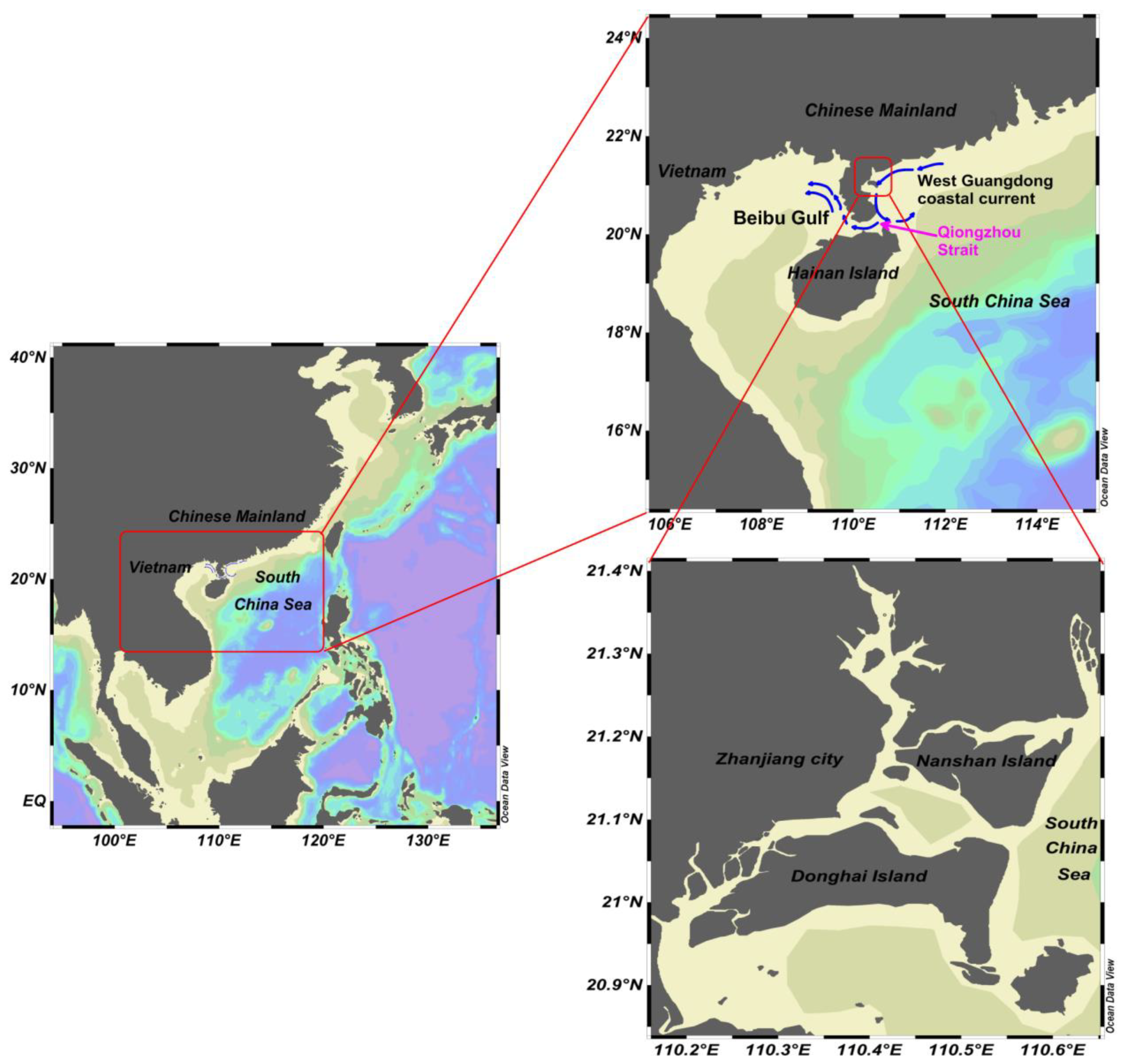
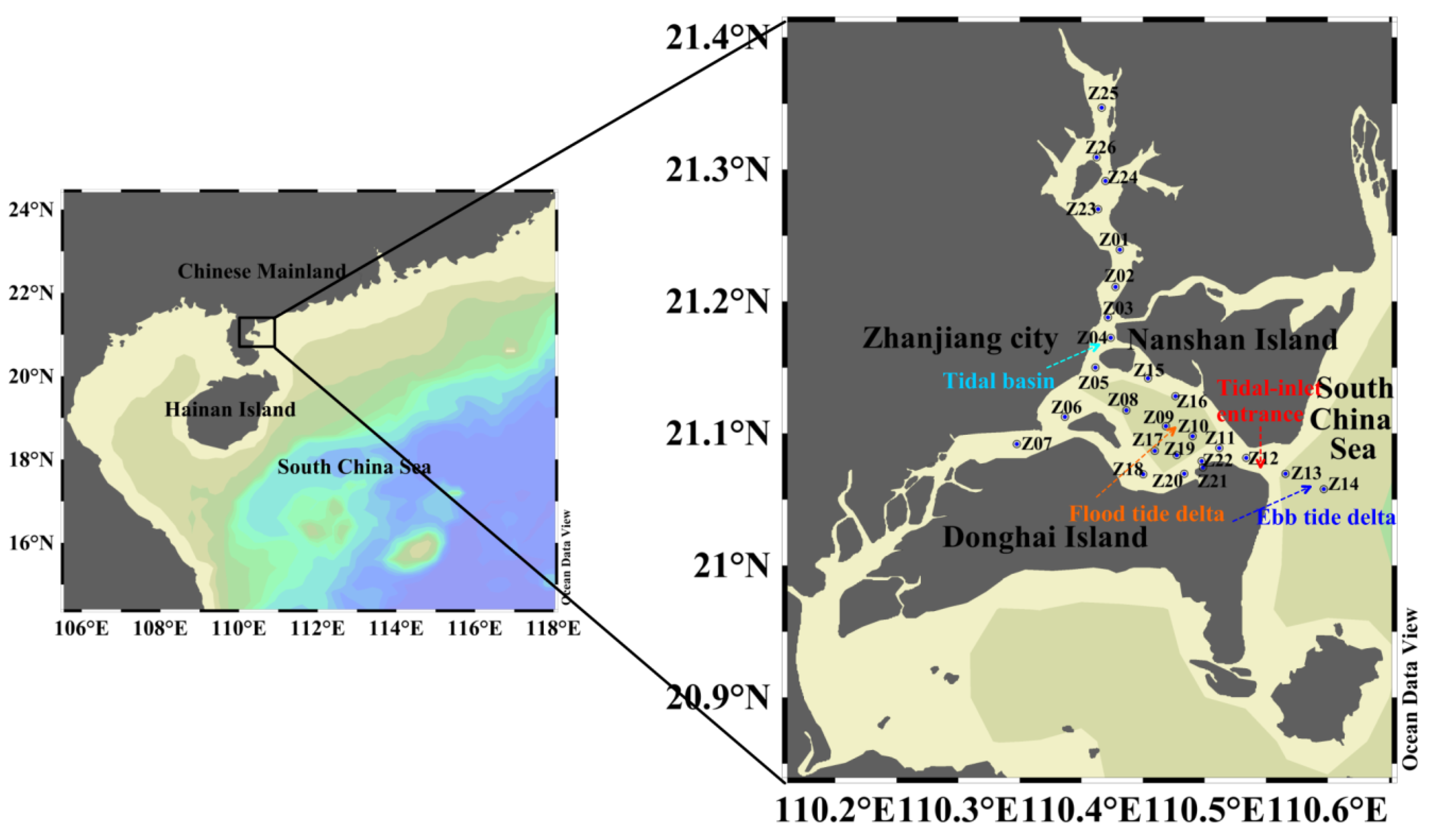

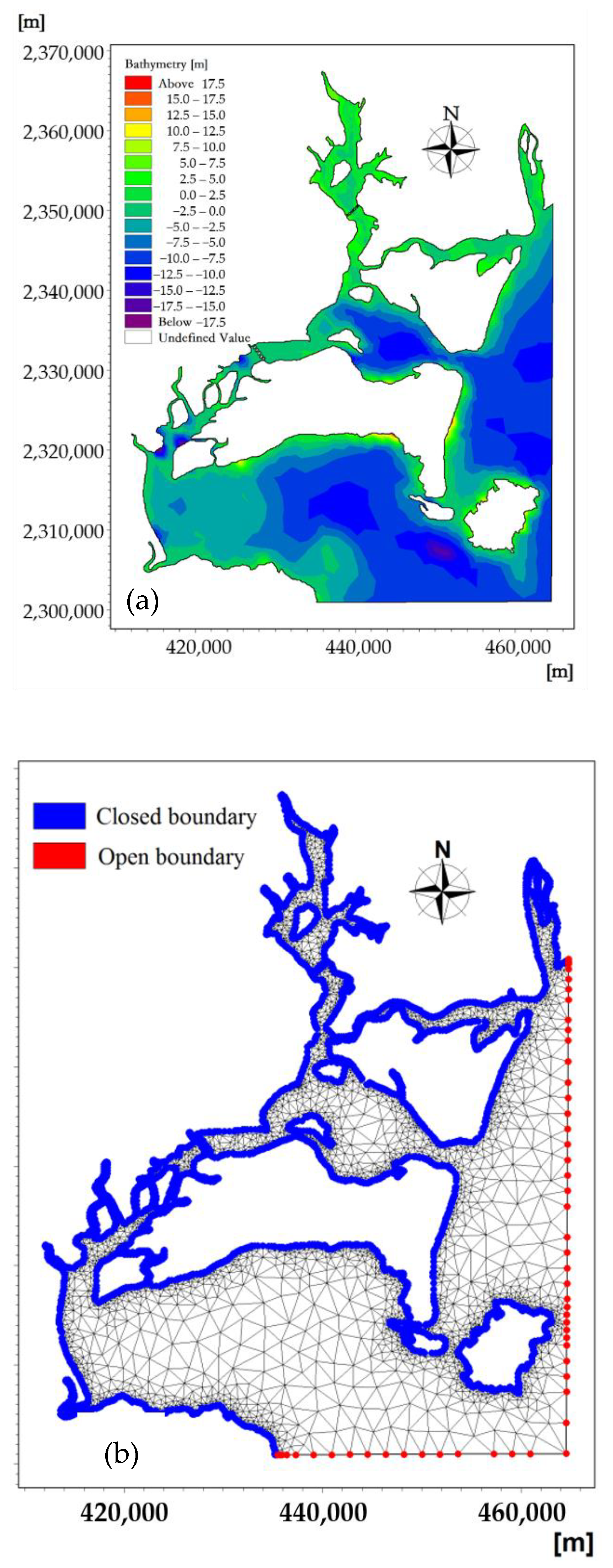

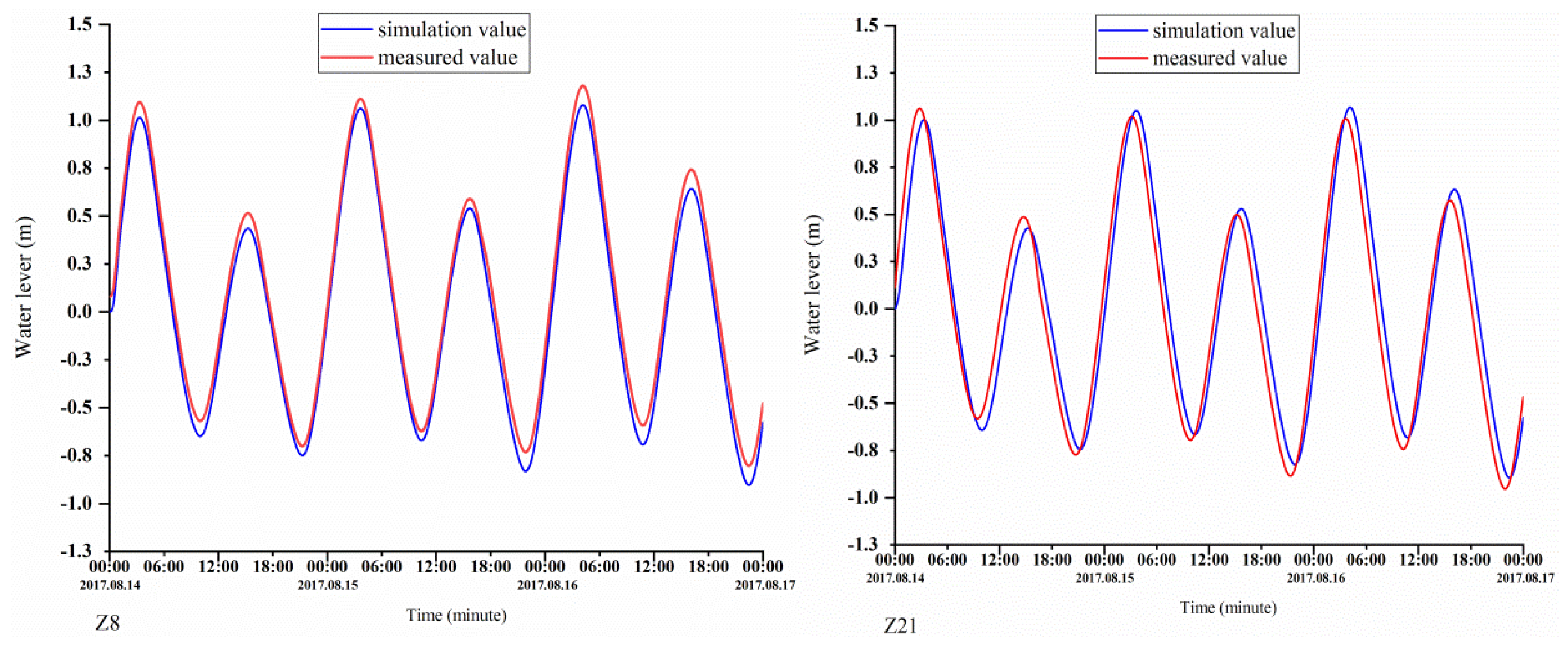
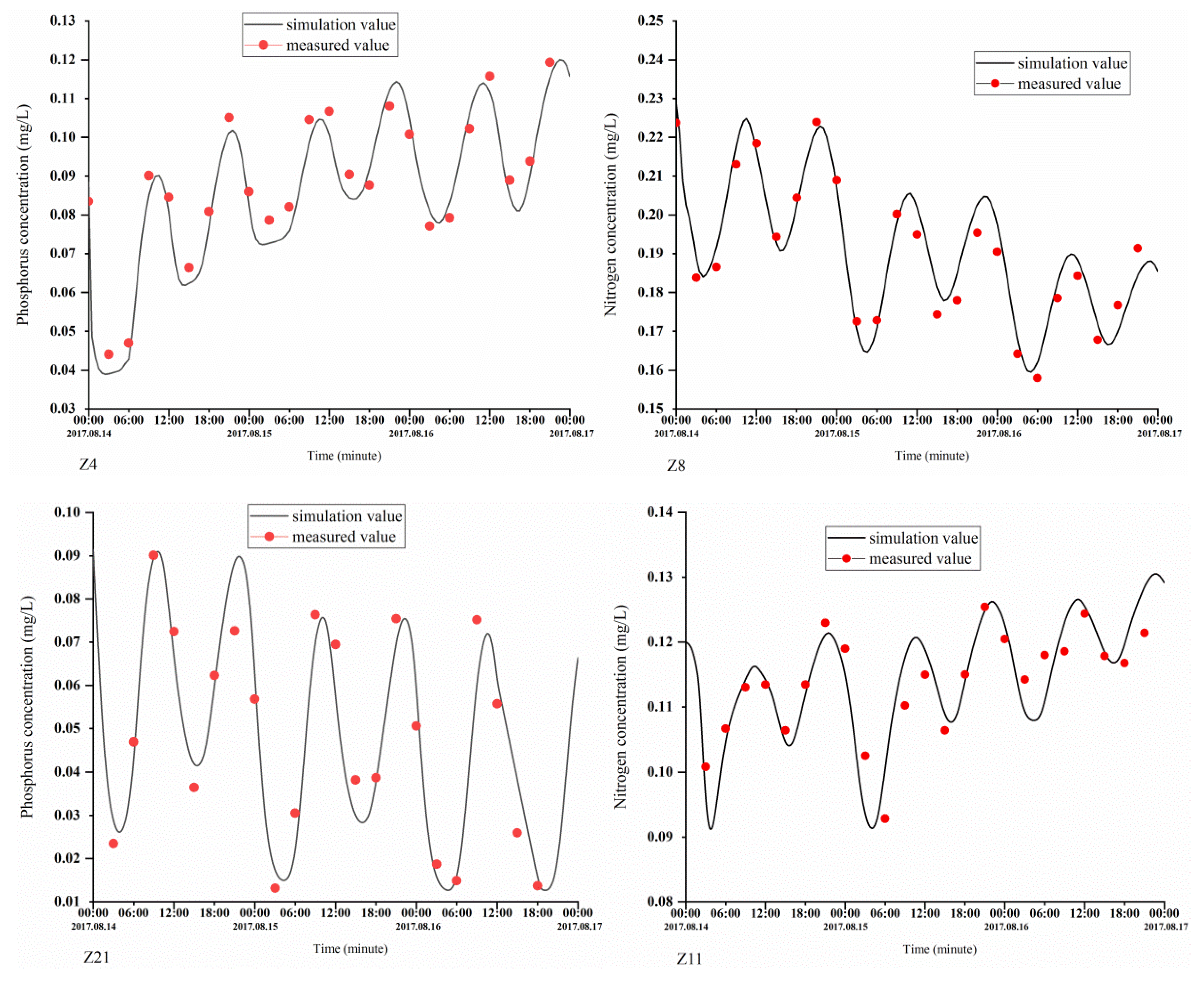
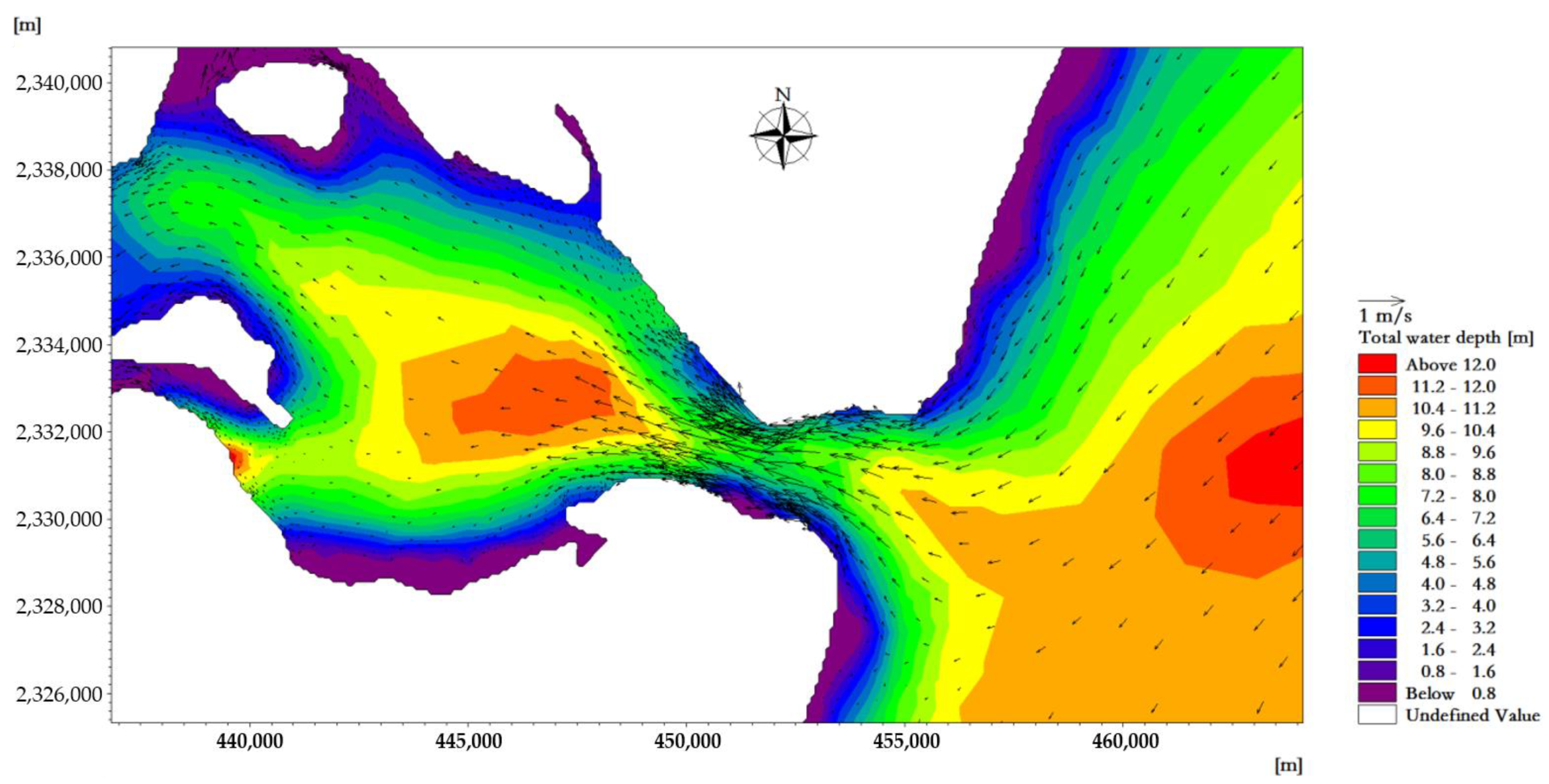
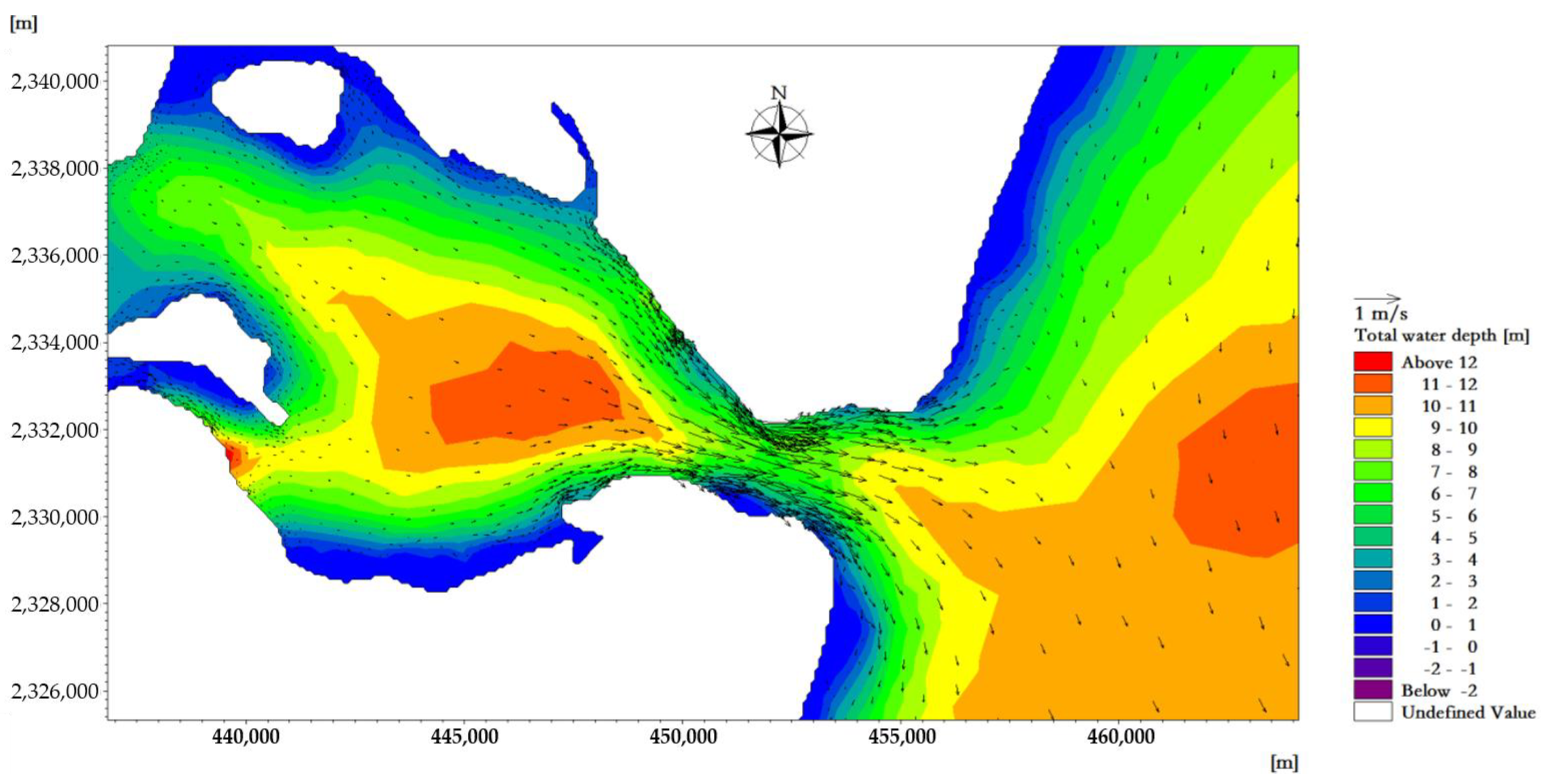

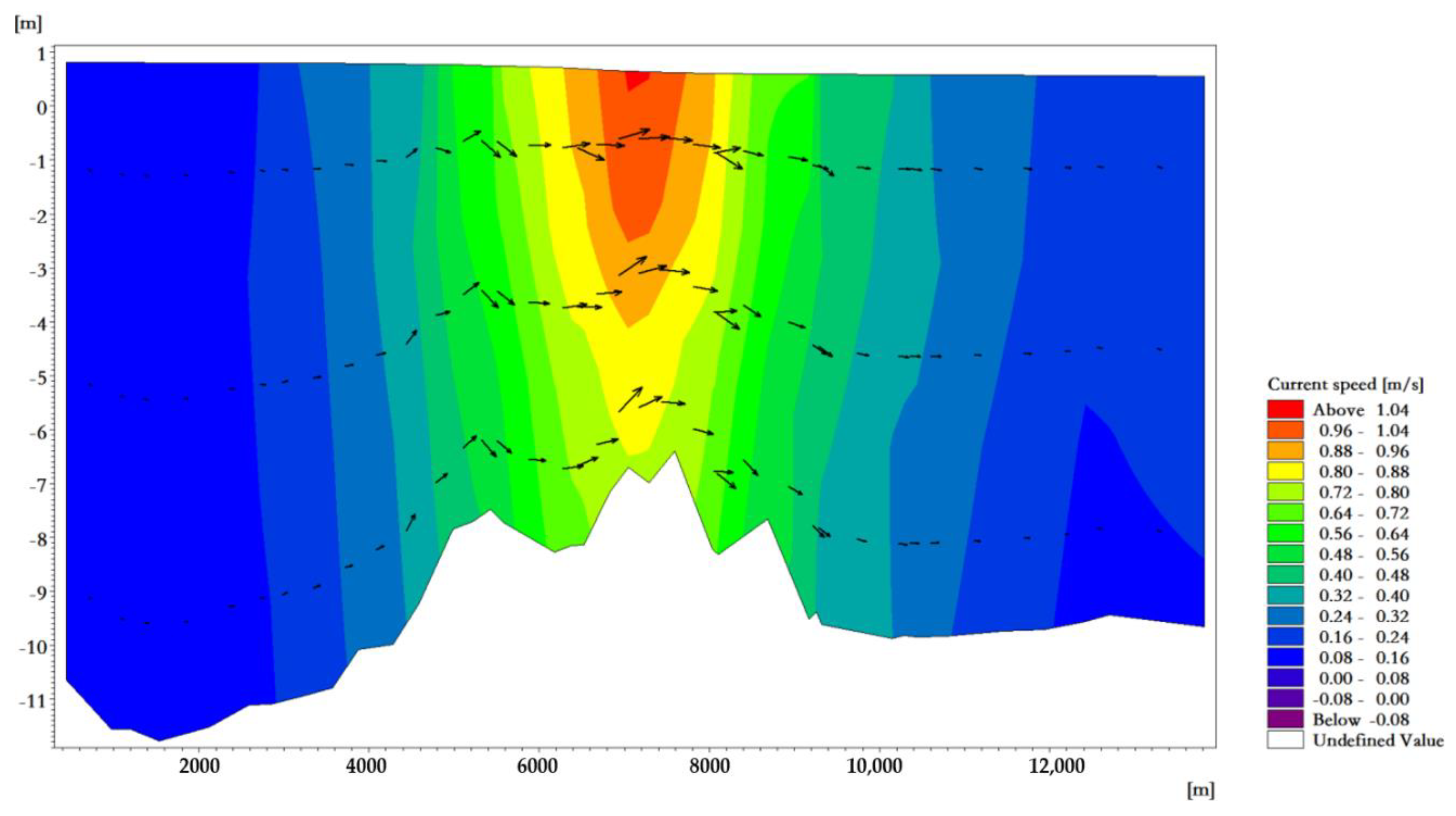
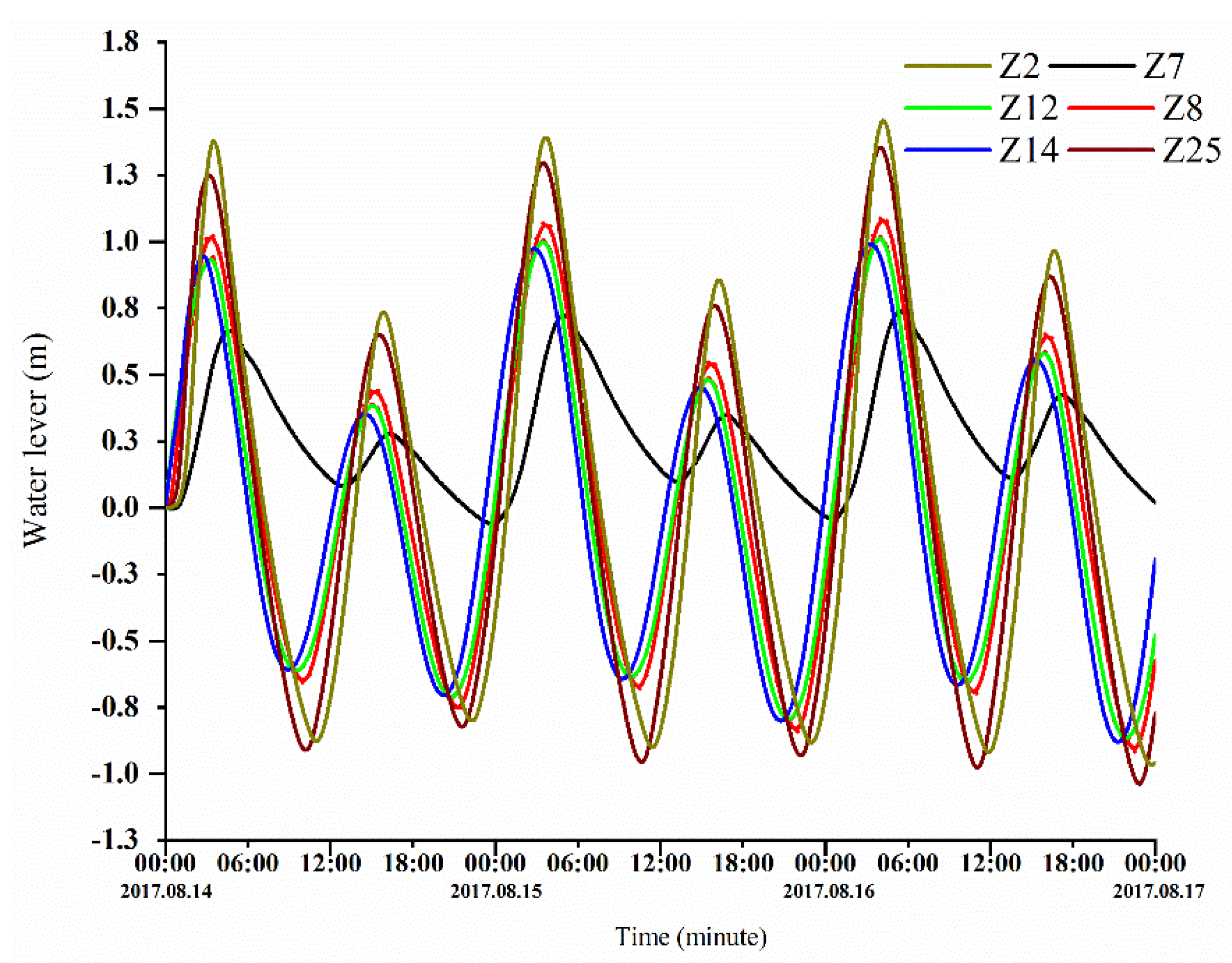


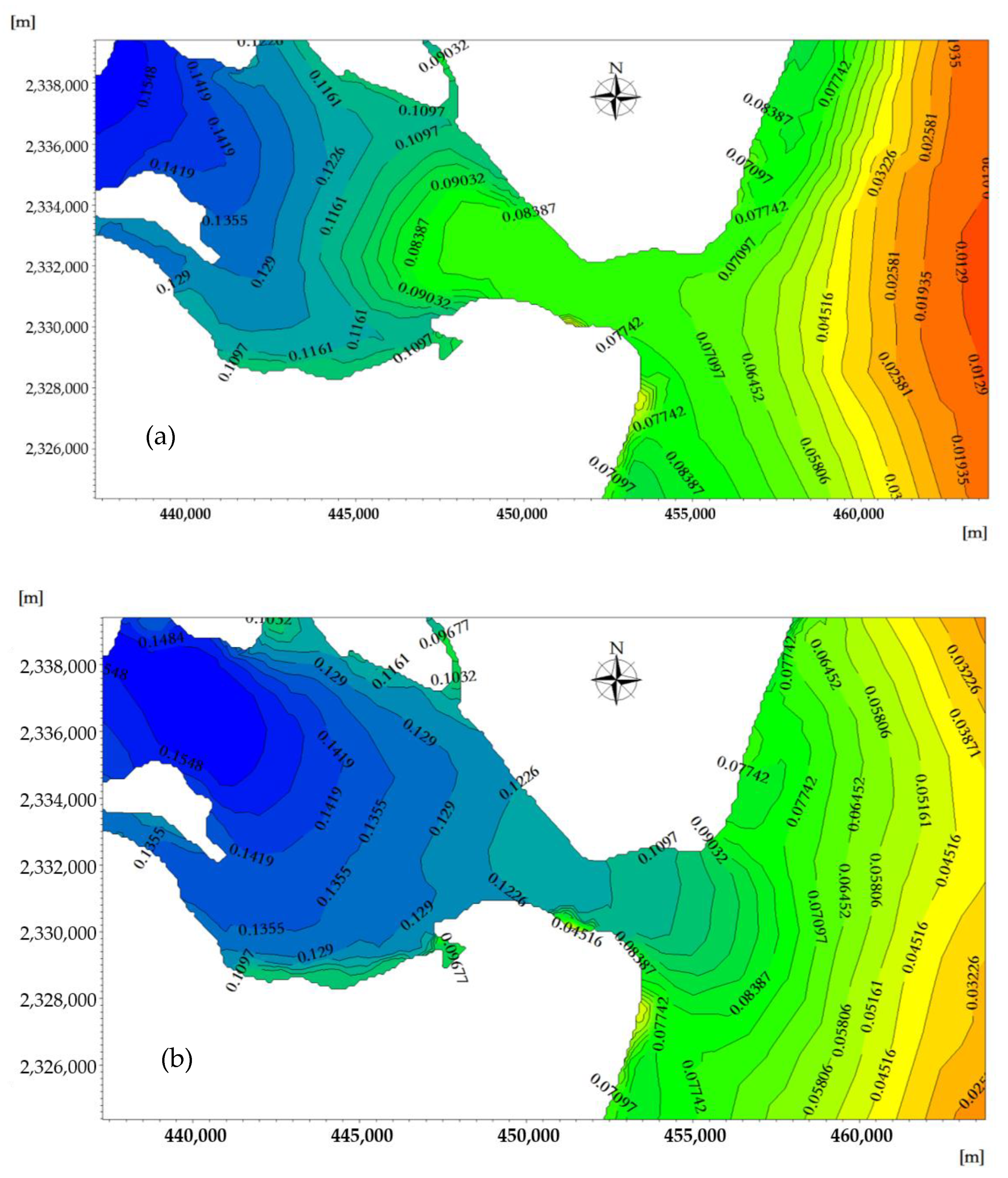


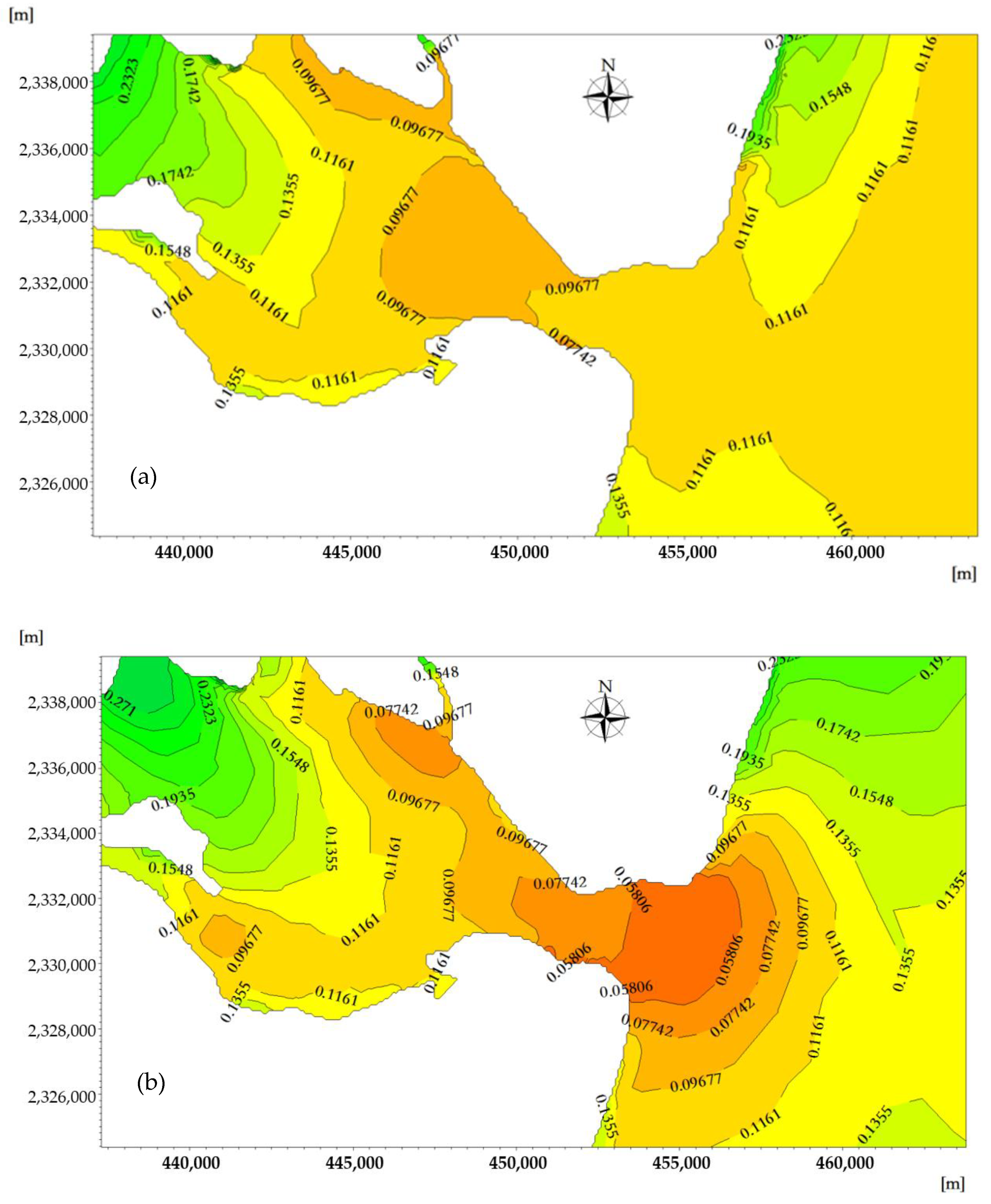
Publisher’s Note: MDPI stays neutral with regard to jurisdictional claims in published maps and institutional affiliations. |
© 2021 by the authors. Licensee MDPI, Basel, Switzerland. This article is an open access article distributed under the terms and conditions of the Creative Commons Attribution (CC BY) license (http://creativecommons.org/licenses/by/4.0/).
Share and Cite
Wang, S.; Zhou, F.; Chen, F.; Meng, Y.; Zhu, Q. Spatiotemporal Distribution Characteristics of Nutrients in the Drowned Tidal Inlet under the Influence of Tides: A Case Study of Zhanjiang Bay, China. Int. J. Environ. Res. Public Health 2021, 18, 2089. https://doi.org/10.3390/ijerph18042089
Wang S, Zhou F, Chen F, Meng Y, Zhu Q. Spatiotemporal Distribution Characteristics of Nutrients in the Drowned Tidal Inlet under the Influence of Tides: A Case Study of Zhanjiang Bay, China. International Journal of Environmental Research and Public Health. 2021; 18(4):2089. https://doi.org/10.3390/ijerph18042089
Chicago/Turabian StyleWang, Shuangling, Fengxia Zhou, Fajin Chen, Yafei Meng, and Qingmei Zhu. 2021. "Spatiotemporal Distribution Characteristics of Nutrients in the Drowned Tidal Inlet under the Influence of Tides: A Case Study of Zhanjiang Bay, China" International Journal of Environmental Research and Public Health 18, no. 4: 2089. https://doi.org/10.3390/ijerph18042089
APA StyleWang, S., Zhou, F., Chen, F., Meng, Y., & Zhu, Q. (2021). Spatiotemporal Distribution Characteristics of Nutrients in the Drowned Tidal Inlet under the Influence of Tides: A Case Study of Zhanjiang Bay, China. International Journal of Environmental Research and Public Health, 18(4), 2089. https://doi.org/10.3390/ijerph18042089




